-
Máquina de Coser
Logical-relational database in the form of a chat that “learns” and modifies its “linguistic behavior” on the basis of interaction with viewers. PC components, keyboard, two dismantled 19” monitors, acrylic, packing tape, OKI 320 continuous-form printer, sewing machine, and scaffolding structure, 110 x 250 x 150 cm., Trienal de Chile, Santiago, Chile, 2009.
SEE IMAGE IN FULL SIZE -
Máquina de Coser
Detail of the machine interacting with a spectator / user, Trienal de Chile, Santiago, Chile, 2009.
SEE IMAGE IN FULL SIZE -
Máquina de Coser
Fragment of a conversation between the machine and a spectator / user called Carmen, Trienal de Chile, Santiago, Chile, 2009.
SEE IMAGE IN FULL SIZE -
Máquina de Coser
Máquina de coser embroidering a word on a white ribbon, Trienal de Chile, Santiago, Chile, 2009.
SEE IMAGE IN FULL SIZE -
Máquina de Coser
Máquina de coser embroidering a word on a white ribbon, Trienal de Chile, Santiago, Chile, 2009.
SEE IMAGE IN FULL SIZE -
Máquina de Coser
Máquina de coser embroidering a word on a white ribbon, Trienal de Chile, Santiago, Chile, 2009.
SEE IMAGE IN FULL SIZE -
Máquina de Coser
Máquina de coser interacting with a group of spectators / users, Trienal de Chile, Santiago, Chile, 2009.
SEE IMAGE IN FULL SIZE -
Máquina de Coser
A spectator / user reading words embroidered by the machine on a white ribbon, Trienal de Chile, Santiago, Chile, 2009.
SEE IMAGE IN FULL SIZE -
Máquina de Coser
Sewing Machine interacting with a group of spectators / usersn, Trienal de Chile, Santiago, Chile, 2009.
SEE IMAGE IN FULL SIZE -
Máquina de Coser
Logical-relational database in the form of a chat that “learns” and modifies its “linguistic behavior” on the basis of interaction with viewers. PC components, keyboard, two dismantled 19” monitors, acrylic, packing tape, OKI 320 continuous-form printer, sewing machine, and scaffolding structure, 110 x 250 x 150 cm., Trienal de Chile, Santiago, Chile, 2009.
SEE IMAGE IN FULL SIZE -
Máquina de Coser
Máquina de coser interacting with a spectator / user, Trienal de Chile, Santiago, Chile, 2009.
SEE IMAGE IN FULL SIZE -
Máquina de Coser
-
Máquina de Coser
Fragment of the Máquina de Coser manifesto on a monitor, Trienal de Chile, Santiago, Chile, 2009.
It says:
The objective of this sewing machine is to become a dia-logic machine. Through the initial use of the algorithm deployed to generate answers, which a search engine retrieves from the works in the index, on the one hand, and the determinism of the pre-programmed responses, on the other, the machine prompts the slow (or not-so-slow) emergence of collective patterns of responses to diverse stimuli delivered through the chat. In this way, a principle of dynamic and emergent causality is introduced to a work of art that is never fully completed, just like the world itself.
The title refers to one of the paradigms of avantgarde art: chance. It is a reference to Lautréamont: “beautiful as the chance encounter of a sewing machine and an umbrella on a dissecting table.” And so, if one of the slogans of the historical avant-garde movements was that of the confrontation between fragmentation and order, what I would like to do is confront this avantgarde model with the (co)emergence of patterns of that fragmented world. This would seem to be something more —or less— than a sum of disconnected fragments, The only real likelihood seems to be the permanent formation of relational structures that are sometimes ephemeral, sometimes inescapably singular in their difference, sometimes more persistent, but in any case unlikely to be eternal. This is —or would seem to be—a phenomenon that not only affects the visual arts, or the human and social sciences but natural sciences as well: How did life, the universe, and the organic world come out of that initial chaos of the Big Bang? How do thoughts or feelings emerge from a neural network? We have the privilege of using a mini universe to test these intuitions. That mini universe is the conjunction between natural language and the people that use this machine. In ordinary language patterns are easily read by any everyday viewer, and moreover they express, with relative clarity, mental states like feelings, thoughts, desires and beliefs.
SEE IMAGE IN FULL SIZE
Máquina de Coser
Máquina de Coser (in English: Sewing Machine) (2009 – ongoing) is an experiment on Artificial Intelligence in the form of chat that learns and modifies its linguistic behavior according to the use given to it by the public.
READ MORE
- Critical References
Living-Networs: Trans-Corporalities and Tecno-individuation, Gómez, Diego, La fuga Magazine, Nº 25, (Dossier images, bodies, algorithms), Santiago, 2021.
The Unhappy Gene, Schopf, Demian, (Rojas, Sergio [editor]), [cuatro treintaitrés] Magazine, Nº 4, (Dossier Art on the Frontiers of Posthumanism, Visual Arts Departament, Faculty of Arts, Universidad de Chile, Santiago, 2021.
Sewing Machine , Schopf, Demian, (Gómez, Diego and Gómez Moya, Cristián [Editors]), CANAL: Visual and Media Studies Notebooks, Nº 1 (Dossier Archaeological Machines) Visual and Media Studies Program, Faculty of Architecture and Urbanism, Universidad de Chile, Santiago, 2017.
Two Sewing Machines
Schopf, Demian, (Cruz, Daniel [editor]), Mediation Technologies, MA in Media Arts, Faculty of Arts, Universidad de Chile, 2015.
Sewing Machines. Logical Machines, Poetical Automatons and Natural Language in Contemporary Media Arts
Universidad de Chile, Faculty of Arts, Thesis to obtain the Degree of Doctor in Philosophy with an MA in Aesthetics and Art Theory, 2015. - Interviews
Digital Matters are a Problem that Totally Belongs to Language, Digital Culture Chile, 2018, Santiago, Chile.
Carolina Gaínza
Demian Schopf - Sewing Machine, 2010, Santiago, Chile.
Daniel Reyes León
Máquina de Coser
Máquina de Coser (in English: Sewing Machine) (2009 – ongoing) is an experiment on Artificial Intelligence in the form of chat that learns and modifies its linguistic behavior according to the use given to it by the public.
READ MORE
- Critical References
Living-Networs: Trans-Corporalities and Tecno-individuation, Gómez, Diego, La fuga Magazine, Nº 25, (Dossier images, bodies, algorithms), Santiago, 2021.
The Unhappy Gene, Schopf, Demian, (Rojas, Sergio [editor]), [cuatro treintaitrés] Magazine, Nº 4, (Dossier Art on the Frontiers of Posthumanism, Visual Arts Departament, Faculty of Arts, Universidad de Chile, Santiago, 2021.
Sewing Machine , Schopf, Demian, (Gómez, Diego and Gómez Moya, Cristián [Editors]), CANAL: Visual and Media Studies Notebooks, Nº 1 (Dossier Archaeological Machines) Visual and Media Studies Program, Faculty of Architecture and Urbanism, Universidad de Chile, Santiago, 2017.
Two Sewing Machines
Schopf, Demian, (Cruz, Daniel [editor]), Mediation Technologies, MA in Media Arts, Faculty of Arts, Universidad de Chile, 2015.
Sewing Machines. Logical Machines, Poetical Automatons and Natural Language in Contemporary Media Arts
Universidad de Chile, Faculty of Arts, Thesis to obtain the Degree of Doctor in Philosophy with an MA in Aesthetics and Art Theory, 2015. - Interviews
Digital Matters are a Problem that Totally Belongs to Language, Digital Culture Chile, 2018, Santiago, Chile.
Carolina Gaínza
Demian Schopf - Sewing Machine, 2010, Santiago, Chile.
Daniel Reyes León
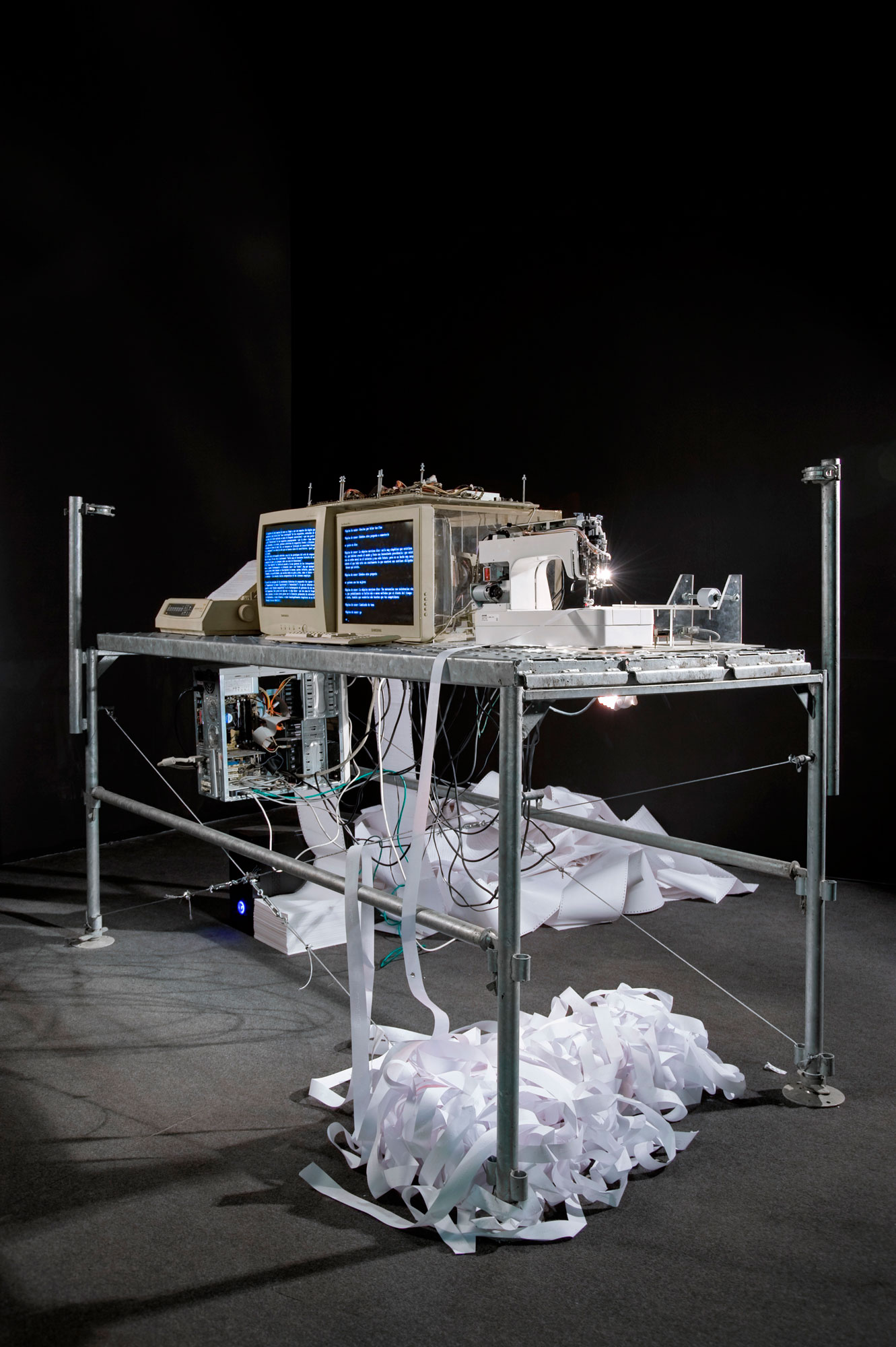
Logical-relational database in the form of a chat that “learns” and modifies its “linguistic behavior” on the basis of interaction with viewers. PC components, keyboard, two dismantled 19” monitors, acrylic, packing tape, OKI 320 continuous-form printer, sewing machine, and scaffolding structure, 110 x 250 x 150 cm., Trienal de Chile, Santiago, Chile, 2009.
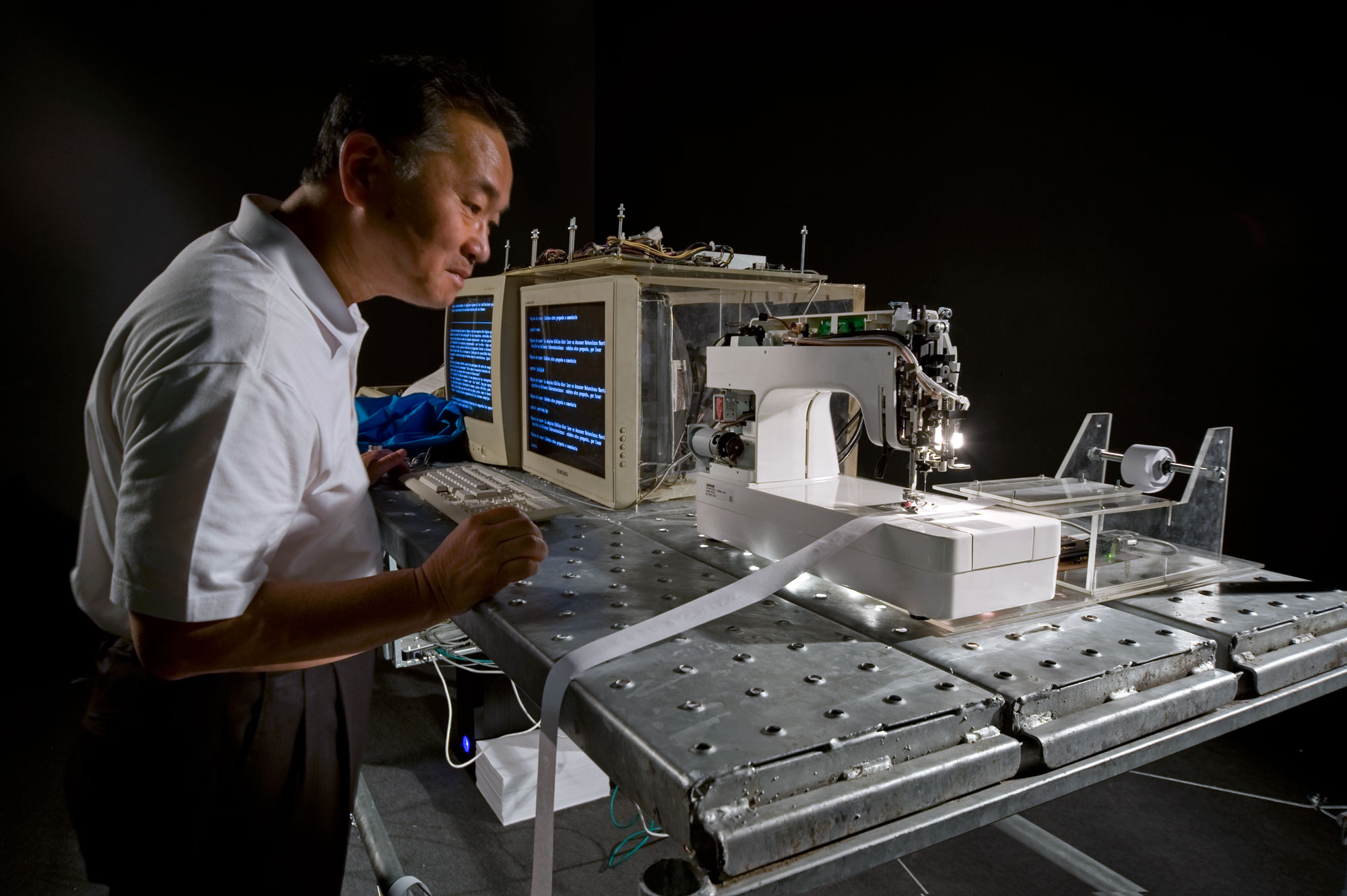
Detail of the machine interacting with a spectator / user, Trienal de Chile, Santiago, Chile, 2009.

Fragment of a conversation between the machine and a spectator / user called Carmen, Trienal de Chile, Santiago, Chile, 2009.
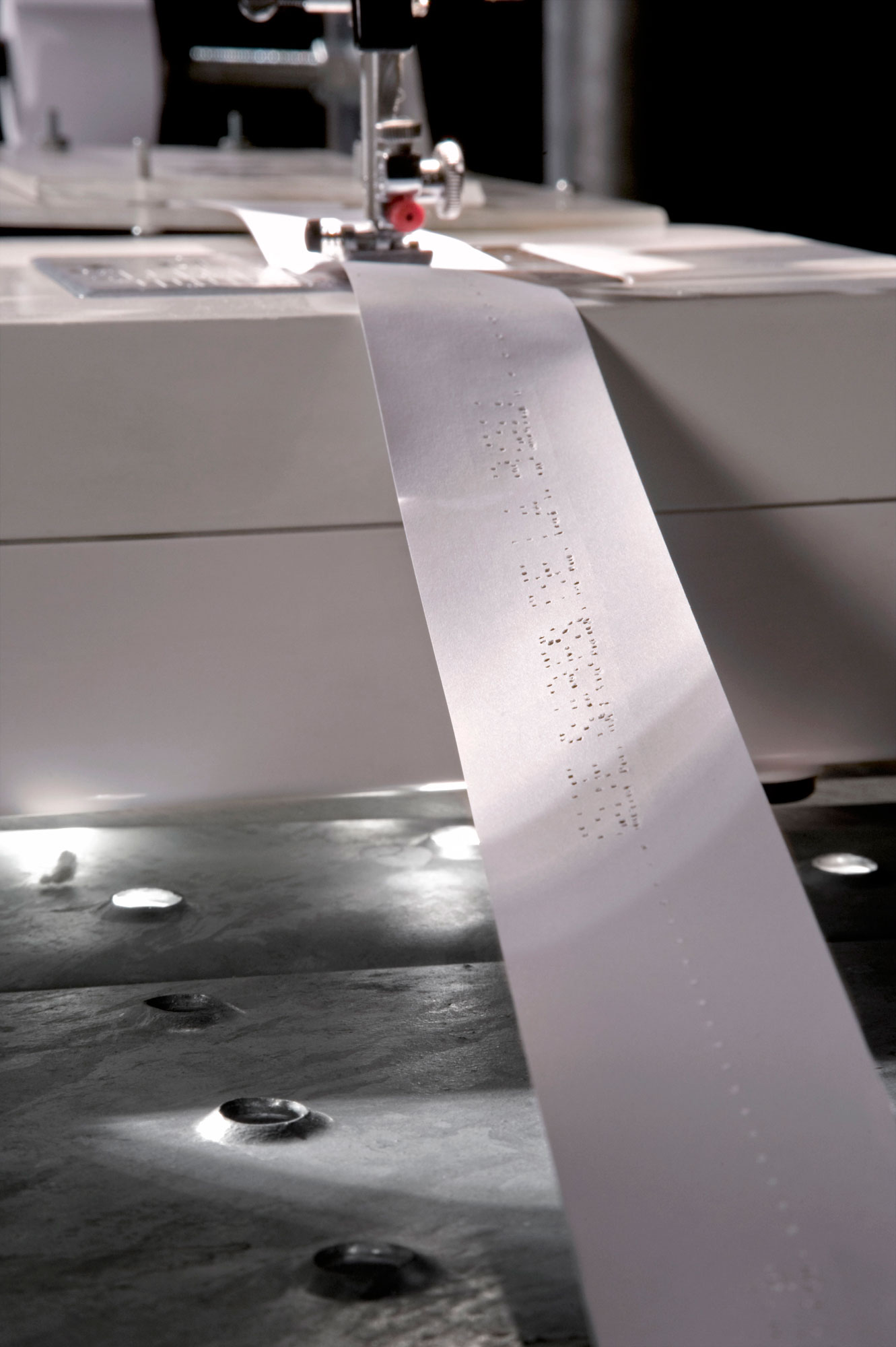
Máquina de coser embroidering a word on a white ribbon, Trienal de Chile, Santiago, Chile, 2009.
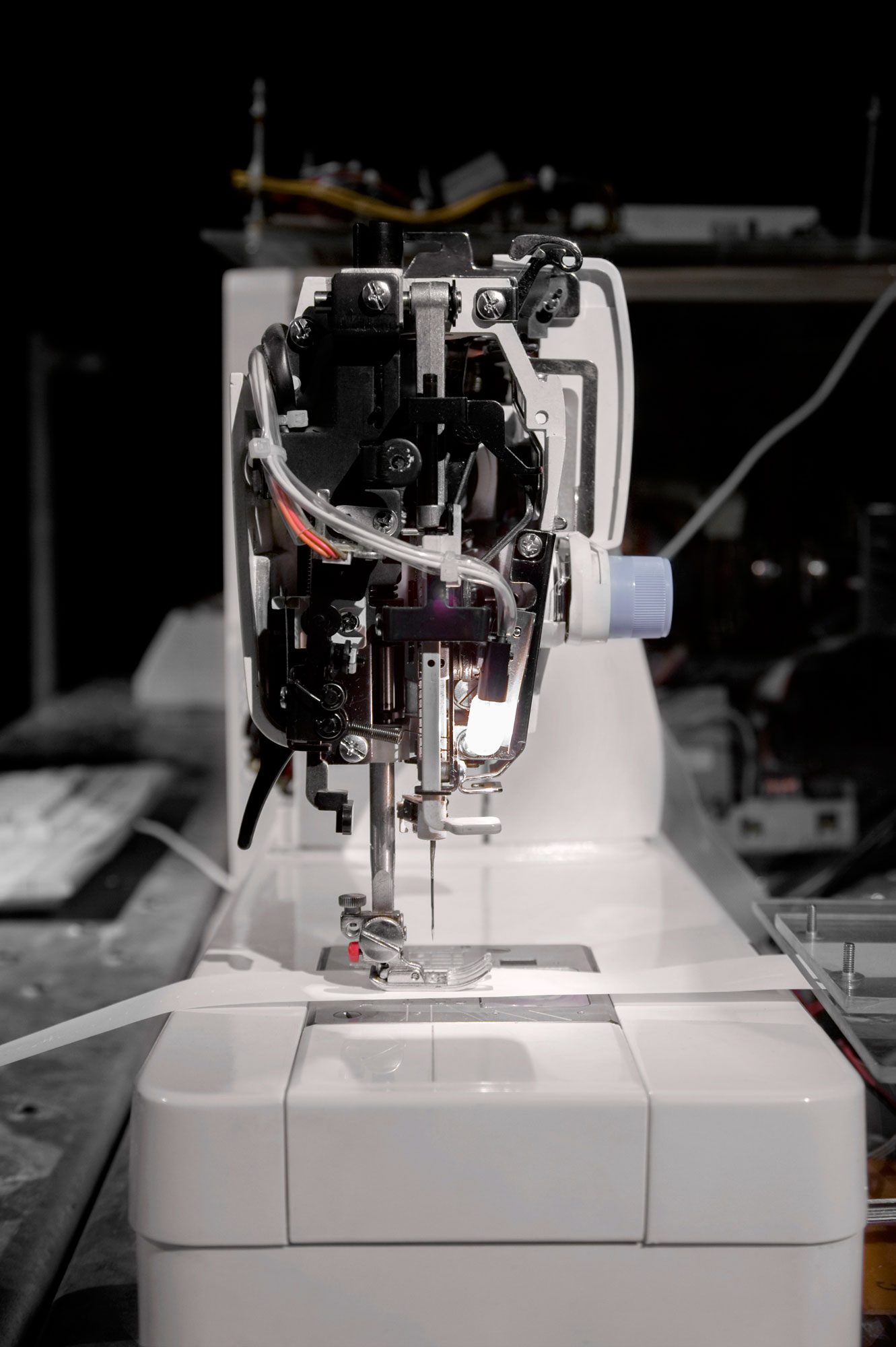
Máquina de coser embroidering a word on a white ribbon, Trienal de Chile, Santiago, Chile, 2009.
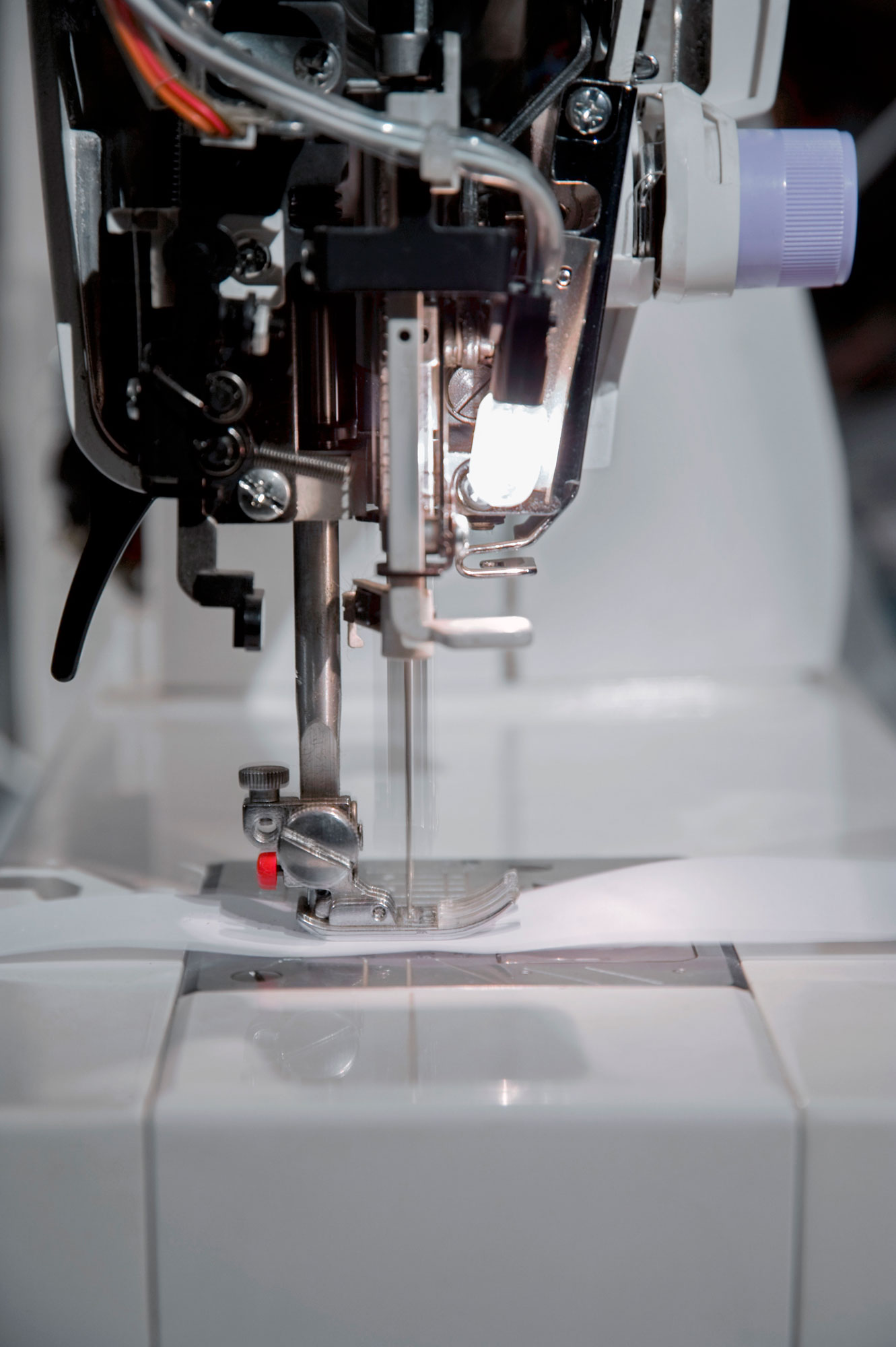
Máquina de coser embroidering a word on a white ribbon, Trienal de Chile, Santiago, Chile, 2009.
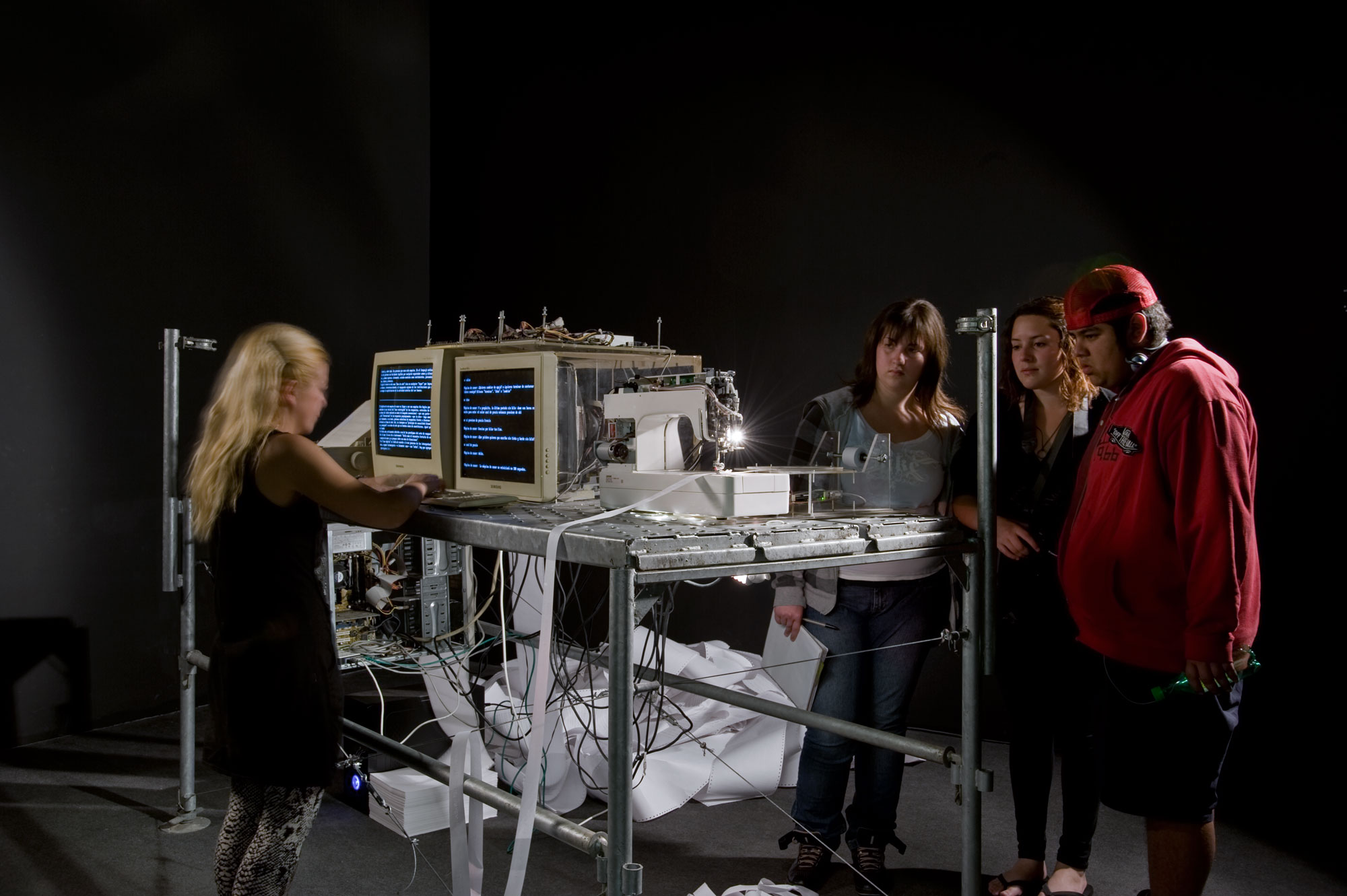
Máquina de coser interacting with a group of spectators / users, Trienal de Chile, Santiago, Chile, 2009.

A spectator / user reading words embroidered by the machine on a white ribbon, Trienal de Chile, Santiago, Chile, 2009.
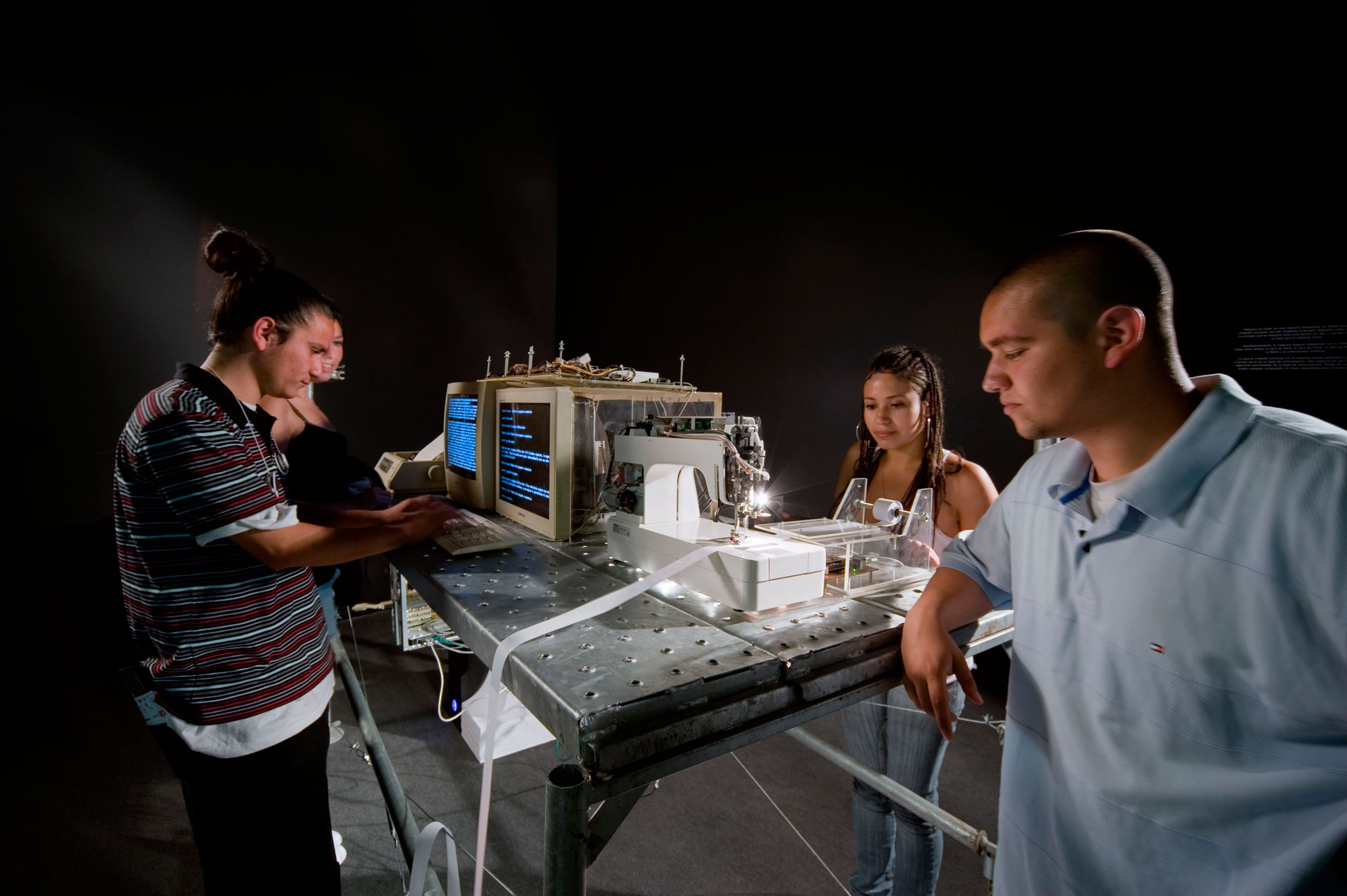
Sewing Machine interacting with a group of spectators / usersn, Trienal de Chile, Santiago, Chile, 2009.
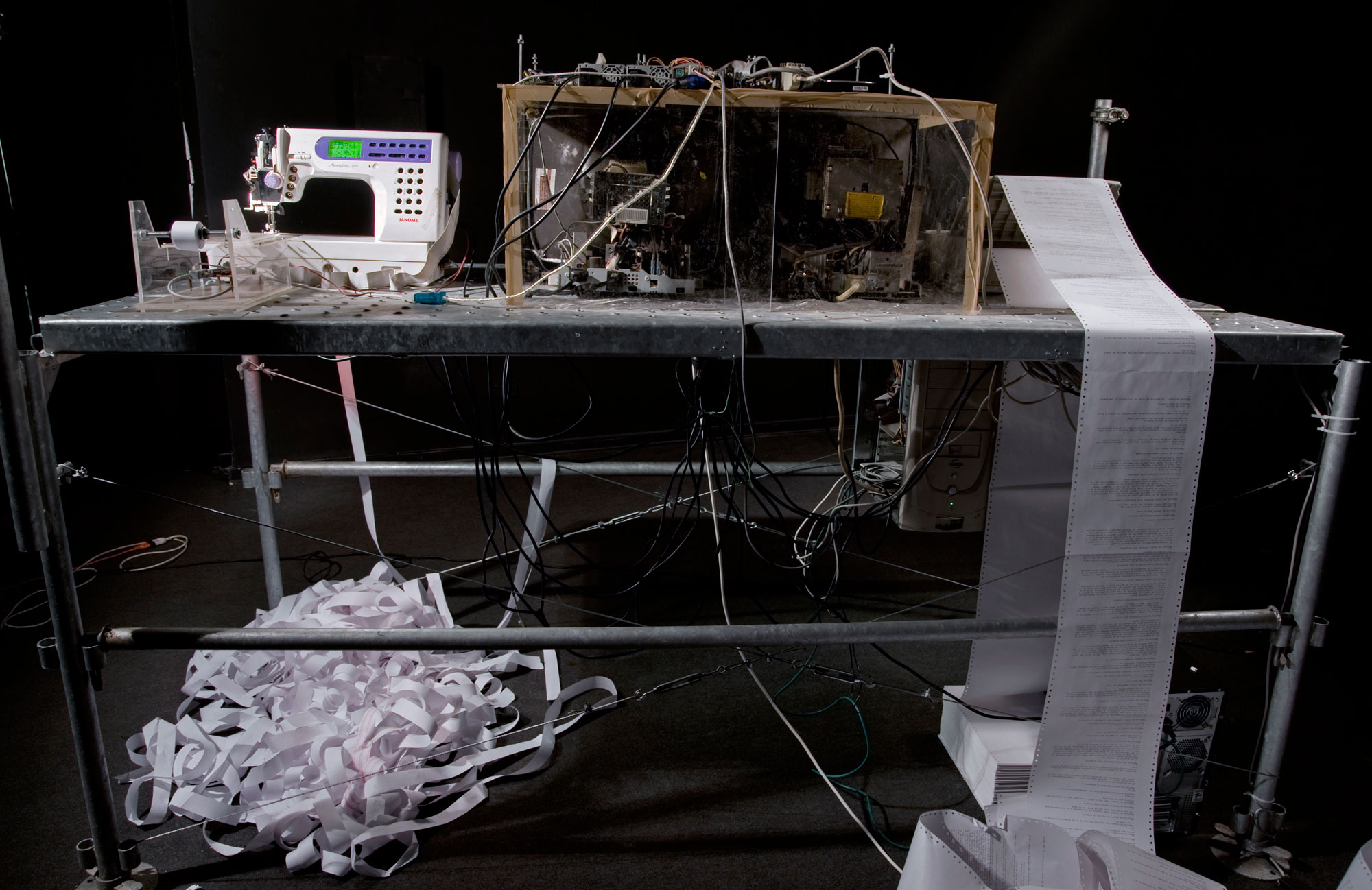
Máquina de Coser, posterior view, Trienal de Chile, Santiago, Chile, 2009.

Máquina de coser interacting with a spectator / user, Trienal de Chile, Santiago, Chile, 2009.
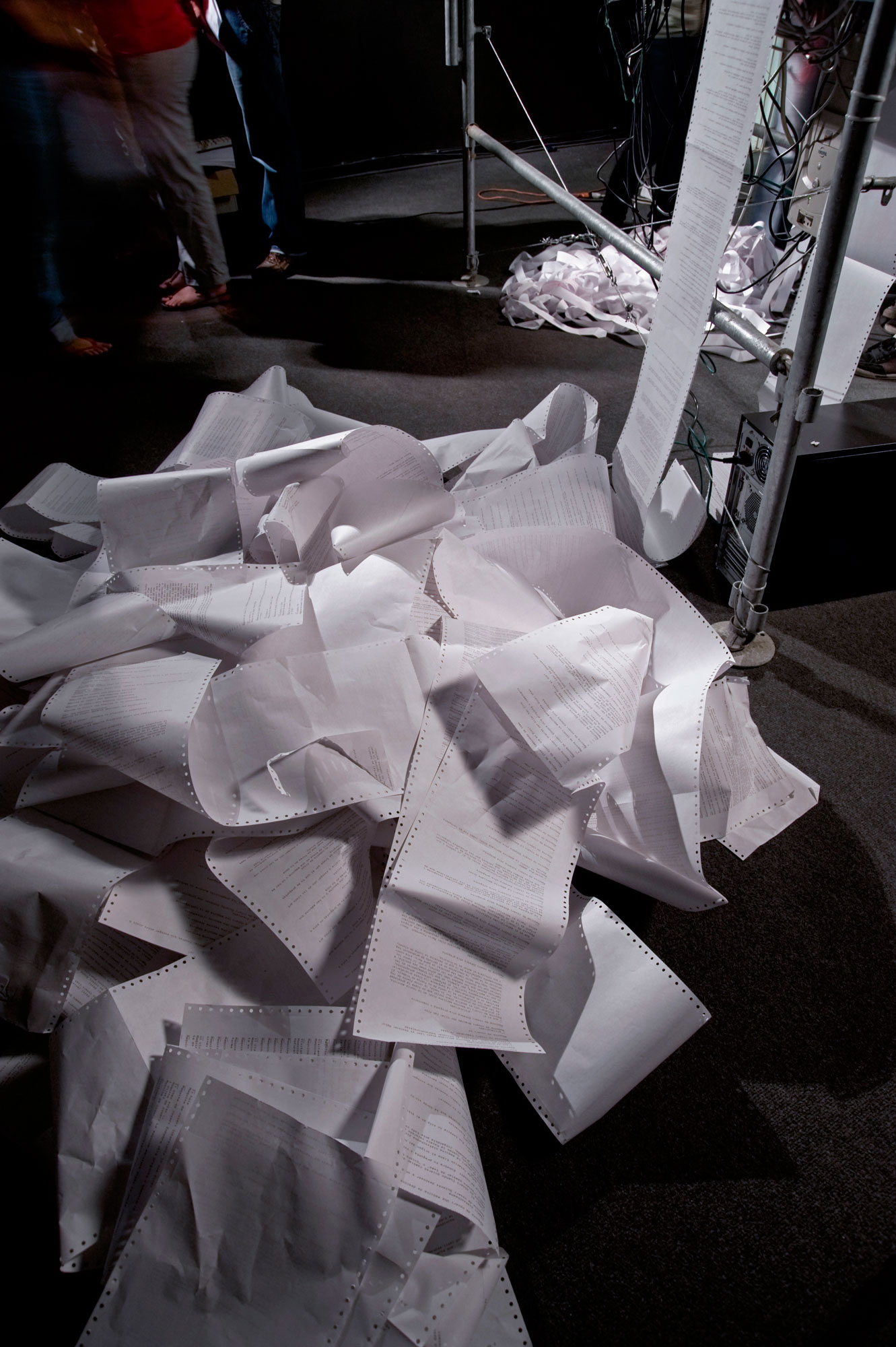
Printed dialogs between man and machine.
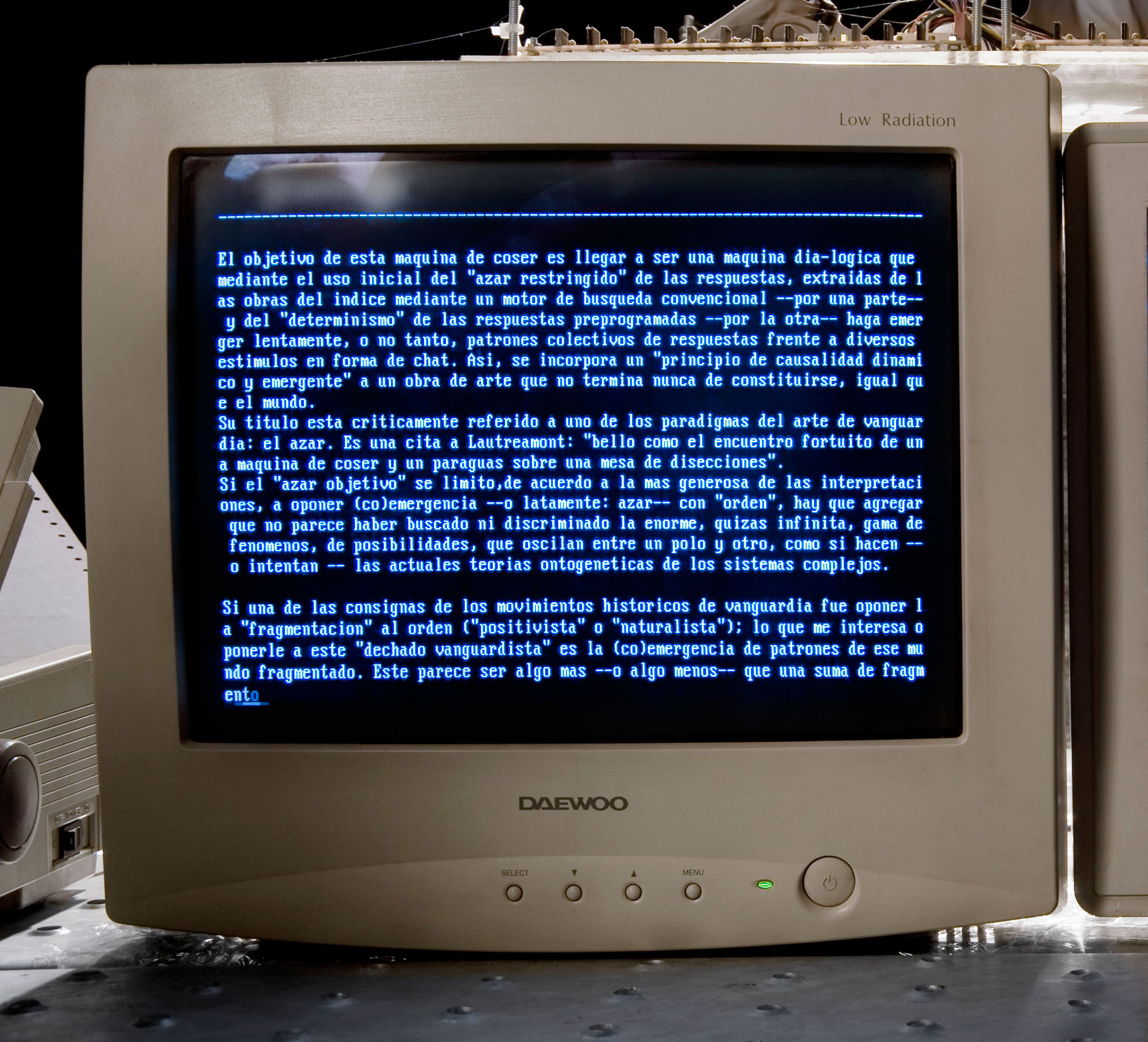
Fragment of the Máquina de Coser manifesto on a monitor, Trienal de Chile, Santiago, Chile, 2009.
It says:
The objective of this sewing machine is to become a dia-logic machine. Through the initial use of the algorithm deployed to generate answers, which a search engine retrieves from the works in the index, on the one hand, and the determinism of the pre-programmed responses, on the other, the machine prompts the slow (or not-so-slow) emergence of collective patterns of responses to diverse stimuli delivered through the chat. In this way, a principle of dynamic and emergent causality is introduced to a work of art that is never fully completed, just like the world itself.
The title refers to one of the paradigms of avantgarde art: chance. It is a reference to Lautréamont: “beautiful as the chance encounter of a sewing machine and an umbrella on a dissecting table.” And so, if one of the slogans of the historical avant-garde movements was that of the confrontation between fragmentation and order, what I would like to do is confront this avantgarde model with the (co)emergence of patterns of that fragmented world. This would seem to be something more —or less— than a sum of disconnected fragments, The only real likelihood seems to be the permanent formation of relational structures that are sometimes ephemeral, sometimes inescapably singular in their difference, sometimes more persistent, but in any case unlikely to be eternal. This is —or would seem to be—a phenomenon that not only affects the visual arts, or the human and social sciences but natural sciences as well: How did life, the universe, and the organic world come out of that initial chaos of the Big Bang? How do thoughts or feelings emerge from a neural network? We have the privilege of using a mini universe to test these intuitions. That mini universe is the conjunction between natural language and the people that use this machine. In ordinary language patterns are easily read by any everyday viewer, and moreover they express, with relative clarity, mental states like feelings, thoughts, desires and beliefs.












